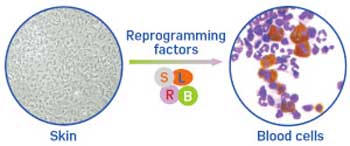| Sep 15, 2017 |
Making blood from skin
|
|
(Nanowerk News) Researchers have long dreamed of producing blood, thereby making donations a thing of the past. Now, thanks to a recent A*STAR study that has successfully made mouse blood and immune cells from skin cells, they are closer to achieving this goal.
|
|
“This represents a first step toward the engineering new human blood cells from skin cells or artificial sources,” notes Bing Lim of the A*STAR Genome Institute of Singapore, who led the study (Nature Communications, "Reprogramming mouse fibroblasts into engraftable myeloerythroid and lymphoid progenitors").
|
 |
| A*STAR researchers have identified four transcription factors that can ‘reprogram’ mouse fibroblast cells, causing them to become different types of blood and immune cells. (Image: A*STAR Genome Institute of Singapore)
|
|
Blood is in short supply and the demand is likely to increase as populations age and fewer people donate. Medical advances which require large volumes of blood, such as chemotherapy, organ transplants and heart surgery, also draw on dwindling stocks.
|
|
Previous studies generated new mouse blood cells from skin cells, but the blood cells produced lasted only two weeks after being injected back into mice. Now, Lim and his co-workers have succeeded in producing artificially skin-derived blood cells that can last up to four months in mice. They identified a cocktail of four transcription factors – proteins involved in the translation of DNA into RNA and that turn nearby genes on and off by binding to DNA – that ‘reprogram’ mouse skin, causing it to develop into different types of blood and immune cells.
|
|
“We’ve been interested in finding out whether it might be possible to rewrite the identity of cells, specifically to turn skin into blood,” says Lim. “Skin cells and blood cells couldn’t be more different. It’s amazing that we have artificially generated blood cells from mouse skin cells.”
|
|
The demonstration has implications beyond just the artificial production of blood. “This is not only of practical importance for regenerative medicine in terms of potentially yielding a source of new blood or immune cells,” says Lim. “It is also interesting from a fundamental biological perspective that two very different cells like skin and blood can be interconverted.”
|
|
The researchers intend to continue to improve their protocol in mice, but they have their sights fixed on extending the technique to human cells so that it can provide a platform to produce new human blood and immune cells.
|

